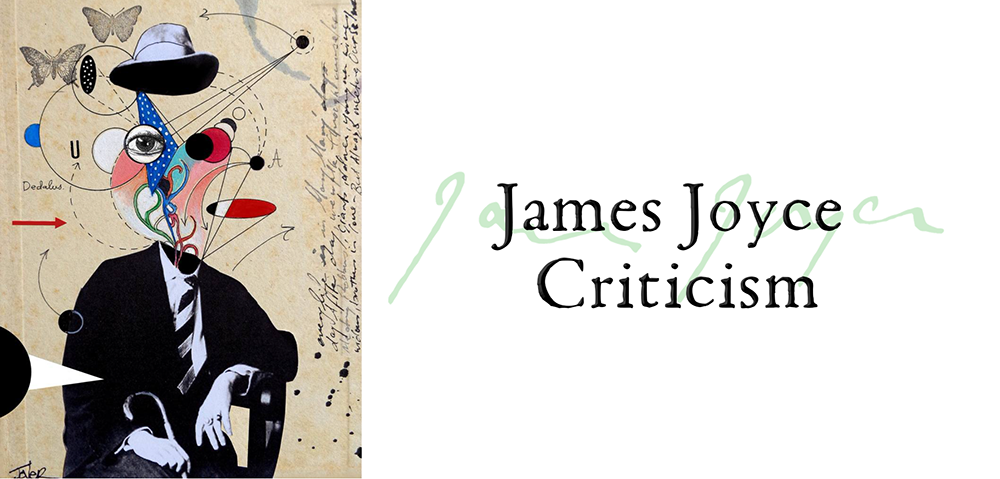Joyce Criticism: “Finnegans Wake” 1. Guides & Annotations
- At January 02, 2022
- By Great Quail
- In Joyce
 0
0
Finnegans Wake: Guides & Annotations
This page profiles guides and annotations for Finnegans Wake. These books are recommended for readers who want a better grasp of the overall structure and narrative of Joyce’s sprawling, complex work. The books are listed by publication date. Clicking a cover image takes you to Amazon.com. Additional Wake criticism may be found by clicking the links below:
Finnegans Wake Criticism
[Main Page | Guides & Annotations | Criticism 1929-1999 | Criticism 2000-Present | About the Wake | Independent]
A Skeleton Key to Finnegans Wake
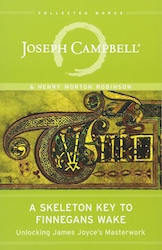
A Skeleton Key to Finnegans Wake
By Joseph Campbell and Henry Morton Robinson
First Edition: Faber and Faber, 1944
Current: New World Library, 2013
Available Online at: Internet Archive
Also available as: Audible Audiobook
One of the first books written about Joyce’s inscrutable novel, A Skeleton Key to Finnegans Wake was co-authored by the celebrated mythologist Joseph Campbell, author of The Hero with a Thousand Faces. The study opens with a beautiful introduction by Campbell, followed by a general synopsis of the Wake. The rest of Skeleton Key breaks down Finnegans Wake page by page, stripping Joyce’s text of its deliberate obscurity and offering possible interpretations through bracketed commentary and footnotes. Essentially, Campbell and Robinson “re-tell” the Wake, “prosifying” the text to make it more comprehensible to the lay reader. While this approach helps to illuminate the “plot” of the Wake, the result is curiously unsatisfying, draining the lifeblood from Joyce’s revolutionary prose by converting his dazzling language into a 300-page telegram. After all, looking at a map of a river is not the same thing as wading through its rushing water! Furthermore, being among the first works of Wakean scholarship, Skeleton Key has been supplanted by other, more detailed studies from the likes of Clive Hart, Margot Norris, William York Tindall, Roland McHugh, and John Bishop; many of whom have disputed or even “overruled” some of Campbell and Robinson’s interpretations. Because of this, A Skeleton Key has lost the luster of its initial pressing, and some Joyceans consider it altogether tarnished, potentially unlocking more doors of misperception than portals of discovery.
Nevertheless, A Skeleton Key remains an important book, and not just for its historical value. Joseph Campbell is a fascinating figure in his own right, and some of his “mythopoetic” insights into the Wake possess a brilliance that’s rarely been matched. (Bob Williams mentions that Skeleton Key should be “praised for what’s really valuable: the treatments of III, 3 and III, 2. These are very helpful analyses. A pity that the rest of the book is not up to this level.”)
A Shorter Finnegans Wake
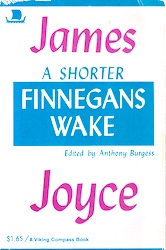
A Shorter Finnegans Wake
By James Joyce. Edited by Anthony Burgess
Viking, 1966
A lifelong enthusiast of James Joyce, Anthony Burgess—author of A Clockwork Orange and many other excellent novels—produced an abridged & explicated version of Finnegans Wake in 1966. This contemporary review from Kirkus offers an excellent summary of the book, and has a delightful cheekiness to boot:
Though James Joyce is safely lodged in the pantheon of modern literature, he still occasions impudent remarks. Now Finnegans Wake, his wordiest aria, and surely the strangest ever sung in any language, has been compressed into a manageable concert performance by Anthony Burgess, distinguished Joycean scholar and dashing word-man himself. Salvaging what he considers the most essential parts, interlocked with a running synopsis of the deleted passages, Burgess has come up with roughly a third of the original text. (The length is a mere 250 pages.) He produces a sort of Noah’s ark, gleanings from that great flood of myth and dreams as filtered through the mind of H.C. Earwicker, our Dublin Everyman, and structured on Viconian cycles (the triadic sequence: religious, heroic, human), or what Joyce calls “the same anew,” while Earwicker, his family, (including the famous Anna Livia Plurabelle), and his friends, swirl through a variety of transpositions, consummations, and resurrections, past and present, till the last line of the book returns us to the first, and man’s eternal saga comes to its paradoxical “hithernadthithering” never-ending close. No doubt pedants will object to the Burgess “cuts” but since he has tastefully selected the more readable portions, accenting Joyce’s robust lyricism and heartiest puns, and kept a good weather-eye open towards shaping the novel’s outrageously double-dealing symbology, A Shorter Finnegans Wake may well prove to be a college favorite, and perhaps even seduce a few stalwarts into attacking the real thing.
A Reader’s Guide to Finnegans Wake
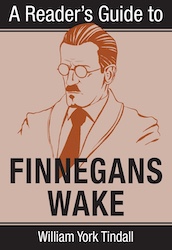
A Reader’s Guide to Finnegans Wake
By William York Tindall
First Edition: Farrar, Straus and Giroux, 1969
Current: Syracuse University Press, 1996
Available Online at: Internet Archive
Probably the most commonly used guide to the Wake, Tindall’s book is intended for the “average” reader. (It says something about Joyce scholarship that anyone reading Finnegans Wake can still be considered an “average” reader!) Tindall sees Joyce as a Symbolist more than anything else, and he contends that Finnegans Wake is a cosmos in a book; a symbolic labyrinth, a vast and inexhaustible work of literature reflecting the entire world. His goal in A Reader’s Guide is to provide a walkthrough of this labyrinth, a tour with frequent stops to admire its design and take delight in its contents.
As befitting a walkthrough, the basic structure of A Reader’s Guide breaks the Wake down chapter by chapter. Tindall outlines the basic “plot” of each chapter, calling attention to the symbolic nature of the characters and how certain elements tend to recur, forming a network of structural leitmotifs that gives the book its overall shape. Tindall is very good at linking key elements in the Wake, a task almost impossible for the first-time reader. He’s also quite adept at unfolding the dazzling levels of meaning Joyce packs into a single word. His sense of humor is quite enjoyable, and he’s gracious in crediting others—especially his many students. On the negative side, his writing can be a bit brisk at times, and often comes across as choppy and disconnected. I find myself wishing that he’d spend more time supporting his arguments. A few comments feel tossed off the cuff, some strike an occasional false note, and others bear the distinct aroma of academic BS. (I occasionally wonder if Tindall’s scatological obsession is a sly critique of Wakean criticism in general!) Fortunately, Tindall freely acknowledges that many of his ideas are conjectures—a refreshing stance for any literary critic.
Despite these quibbles, Tindall’s guide remains an excellent resource for a beginning reader, filled with illuminating insights and friendly advice. One gets the impression that Tindall would welcome anybody at his Wakean Kaffee Klatsch, expert or beginner alike.
Annotations to Finnegans Wake
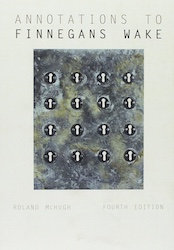
Annotations to Finnegans Wake
By Roland McHugh
First Edition: The Johns Hopkins University Press, 1980
Fourth Edition: The Johns Hopkins University Press, 2014
About the size of an average phone book, McHugh’s Annotations provides exactly what the cover claims: a lot of annotations to Finnegans Wake. A goddamn whole lot of annotations. In fact, McHugh claims to have relocated his home to Dublin just to better understand the Wake. You have to admire that sort of obsession!
Designed so you can read the Wake on top of its open pages, McHugh’s book matches the Wake page for page, line by line, making it easy to take in a note with a quick glance. The Annotations scatter a thousand points of light through Joyce’s nocturnal maze, illuminating intertextual allusions and literary quotations, biographical and historical references, musical notations and songs, geographical places, mythical beings, fragments of philosophy and religion—the list goes on. Additionally, McHugh untangles some of Joyce’s more difficult puns, parodic phrasings, and compound neologisms, often identifying and translating fragments borrowed from other languages. (Often I found myself, when stricken by the incomprehensible suddenly made obvious, slapping my head and muttering, “D’oh!”)
Annotations to Finnegans Wake is invaluable for those who want their Wake well woken, with a full spread of coffee and sandwiches. Although some of McHugh’s interpretations don’t always meet with everyone’s approval, the book is recognized as being the “industry standard,” so to speak, and is itself an evolving work-in-progress.
Finnegans Wake: A Plot Summary
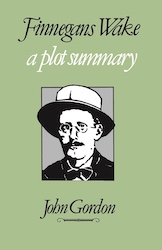
Finnegans Wake: A Plot Summary
By John Gordon
Syracuse University Press, 1986
Available Online at: Internet Archive
Bob Williams: This is an amazing book. Professor Gordon sets out to tell the reader exactly what takes place in Finnegans Wake. He begins with an introduction and five chapters of general considerations. Each of the remaining chapters is devoted to a corresponding chapter of Finnegans Wake. The result is a masterly handling of Wake material and interpretations are derived from the book that Joyce wrote and not, as so often, ruthlessly applied from the fertile brain of the exegete. Would Joyce recognize his book in the guise that Professor Gordon gives it? Probably not, but the book is stimulating and provocative.
Joyce’s Book of the Dark
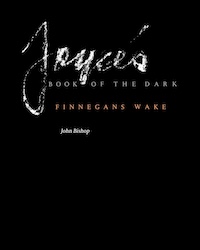
Joyce’s Book of the Dark
By John Bishop
University of Wisconsin, 1986
Available Online at: Internet Archive
Joyce’s Book of the Dark is an incredible work, and unique among the crop of Finnegans Wake guides. Not quite an explication, walkthrough, or set of annotations, Bishop’s book hovers somewhere between a joyous celebration of the Wake and a free-form meditation on its many subjects. Basically, Bishop returns to the text itself, seeing the Wake as a nocturnally-structured work which contains the seeds of its own illumination. Through a series of chapters with titles such as “Nothing in Particular: On English Obliterature” and “Earwickerwork,” Bishop adventurously explores the Wake’s characters and themes, all within the context of Joyce’s stated intention that Finnegans Wake is an “imitation of the dream-state.” Although Bishop generally lets Joyce’s text speak for itself, Joyce’s Book of the Dark is filled with typographical maps, linguistic flowcharts, and even anatomical diagrams, all of which leap off pages already charged with Bishop’s insightful ideas and witty prose. The result is a Wakean Wonderland that takes equal delight in enlightenment or obscurity.
While Bishop’s big “Nightletter” might not be the most appropriate text for the absolute beginner, it goes a long way in making sense of the psychology and texture of the Wake itself. A bit arcane and difficult, yes, but highly recommended.
A Guide through Finnegans Wake

A Guide through Finnegans Wake
By Edmund Lloyd Epstein
University Press of Florida, 2010
Available Online at: Internet Archive
Publisher’s Description: Written in a complex, pun-based idiogloss and boasting a dreamlike narrative that defies conventions of plot and continuity, James Joyce’s Finnegans Wake has been challenging readers since its first publication in 1939. The novel is so famously difficult that it is widely agreed that only the brave or foolhardy attempt to unravel this well-known but relatively little-read classic. Most tackle the text in reading groups, which provide mutual assistance (and moral support) in understanding Joyce’s modern masterpiece. Now, with the publication of Edmund Epstein’s A Guide through Finnegans Wake, no one has to go it alone. Recognized as one of the world’s foremost Joyce scholars, Epstein has been reading and thinking about Joyce for over fifty years, and his considerable experience and enthusiasm is preserved here for the benefit of anyone with an interest in reading the Wake. This accessible guide approaches the daunting work in a way that provides handrails for beginners while, at the same time, presenting new insights for experienced readers.
CONTINUE TO > Finnegans Wake Criticism 1929-1999
Joyce Criticism
[Main Page | General Criticism | Dubliners | Portrait | Ulysses | Finnegans Wake]
Authors: Allen B. Ruch & Bob Williams
Artwork: Loui Jover
Last Modified: 14 June 2024
Main Joyce Page: The Brazen Head
Contact: quail(at)shipwrecklibrary(dot)com

